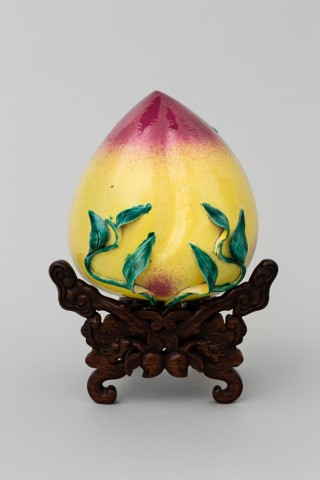BE10
A naturalistic model of a large ripe shoutao, or peach of longevity, with a delicately modelled leafy stalk, finely painted in vibrant famille rose enamels, the stalk painted a bright green, with blushes of pink at the top of the fruit and at the tip, gradually blending into yellow.
Literature
This piece is notable for its naturalistic simulation of a peach, which has been achieved through fine modelling and decoration. The peach is a sign of longevity in Chinese art. Also referred to as the 'Fairy Fruit', it is an emblem of marriage and springtime. The Daoist god of longevity, Shou Lao, is often depicted holding a peach. It is said that the peaches of the magical P'an-t'ao tree of the gods, which blossom once every three thousand years and ripen only after another three thousand years, will confer immortality on those who eat them (see Williams 1976 'Outlines of Chinese Symbolism and Art Motives', pp.209, 226, 315). Models in this style are sometimes known as altar fruit, used at temples to ensure offerings could always be made even when there was no fresh fruit available.
Compare also a waterpot of related form and decoration with a four-character Yongzheng reign mark in black enamel on the base and attributed to the Beijing palace workshops, from the Qing Court collection and still in Beijing, illustrated in The Complete Collection of Treasures of the Palace Museum. Metal-bodied Enamel Ware China. The Three Emperors 1662-1795, Royal Academy of Arts, London, 2005, cat. no. 295

